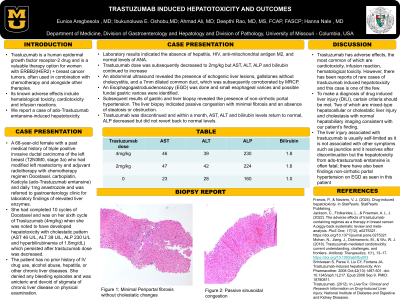Tuesday Poster Session
Category: Liver
P4814 - Trastuzumab-Induced Hepatotoxicity and Outcomes
Tuesday, October 29, 2024
10:30 AM - 4:00 PM ET
Location: Exhibit Hall E

Has Audio

Eunice Aregbesola, MD
University of Missouri Health Care
Columbia, MO
Presenting Author(s)
Eunice Aregbesola, MD1, Ibukunoluwa E. Oshobu, MD1, Ahmad Ali, MD1, Deepthi Rao, MD, MS2, Hanna Nale, MD1
1University of Missouri Health Care, Columbia, MO; 2University of Missouri School of Medicine, Columbia, MO
Introduction: Trastuzumab is a human epidermal growth factor receptor-2 drug which generally has a safe profile with common side
effects of cardiotoxicity and infusion reaction. We report a case of ado-Trastuzumab emtansine-induced
hepatotoxicity with portal hypertension.
Case Description/Methods: A 68-year-old female with a past medical history of triple positive invasive ductal carcinoma of the left
breast ( T2N3M0, stage 3a) had modified left mastectomy and adjuvant radiotherapy with chemotherapy
regimen Docetaxel, carboplatin, Kadcyla (ado-Trastuzumab emtansin)and daily 1mg anastrozole was
referred to gastroenterology clinic for laboratory findings of elevated liver enzymes.
She had completed 10 cycles of Docetaxel and was on her sixth cycle of Trastuzumab (4mg/kg) when
she was noted to have developed hepatotoxicity with cholestatic pattern ( AST 46 U/L, ALT 39 U/L, ALP
230 U/L and hyperbilirubinemia of 1.8mg/dL) which persisted after trastuzumab dose was decreased. The
patient has no history of IV drug use, alcohol abuse, hepatitis, or other chronic liver diseases. She denied
any bleeding episodes and was anicteric and devoid of stigmata of chronic liver disease on physical
examination.
Labs were negative for hepatitis, HIV, anti-mitochondrial antigen M2, and normal ANA values.
Abdominal ultrasound showed echogenic liver lesions, gallstones with no cholecystitis, and a 7mm
dilated common duct, which was consistent on MRCP.
Esophagogastroduodenoscopy (EGD)with gastric and liver biopsy showed non-cirrhotic portal
hypertension, with significant findings for small esophageal and possible fundal gastric varices. A liver
biopsy also showed liver passive congestion with minimal fibrosis and no findings of steatosis.
Months after the medication was discontinued, bilirubin, AST, and ALT values returned to normal, but
ALP elevation persisted.
Discussion: Trastuzumab has adverse effects, the most common of which are cardiotoxicity, hepatotoxicity,
thrombocytopenia, and insomnia.
To make a diagnosis of drug induced liver injury (DILI), certain criteria should be met. Two of which are
mixed-type hepatocellular or cholestatic liver injury and cholestasis with normal hepatobiliary imaging
consistent with our patient’s finding. The liver injury associated with trastuzumab is usually self-limited
as it is not associated with other symptoms such as jaundice, but the hepatotoxicity from ado-trastuzumab
emtansine is often fatal; there have also been findings non-cirrhotic portal hypertension on EGD.

Disclosures:
Eunice Aregbesola, MD1, Ibukunoluwa E. Oshobu, MD1, Ahmad Ali, MD1, Deepthi Rao, MD, MS2, Hanna Nale, MD1. P4814 - Trastuzumab-Induced Hepatotoxicity and Outcomes, ACG 2024 Annual Scientific Meeting Abstracts. Philadelphia, PA: American College of Gastroenterology.
1University of Missouri Health Care, Columbia, MO; 2University of Missouri School of Medicine, Columbia, MO
Introduction: Trastuzumab is a human epidermal growth factor receptor-2 drug which generally has a safe profile with common side
effects of cardiotoxicity and infusion reaction. We report a case of ado-Trastuzumab emtansine-induced
hepatotoxicity with portal hypertension.
Case Description/Methods: A 68-year-old female with a past medical history of triple positive invasive ductal carcinoma of the left
breast ( T2N3M0, stage 3a) had modified left mastectomy and adjuvant radiotherapy with chemotherapy
regimen Docetaxel, carboplatin, Kadcyla (ado-Trastuzumab emtansin)and daily 1mg anastrozole was
referred to gastroenterology clinic for laboratory findings of elevated liver enzymes.
She had completed 10 cycles of Docetaxel and was on her sixth cycle of Trastuzumab (4mg/kg) when
she was noted to have developed hepatotoxicity with cholestatic pattern ( AST 46 U/L, ALT 39 U/L, ALP
230 U/L and hyperbilirubinemia of 1.8mg/dL) which persisted after trastuzumab dose was decreased. The
patient has no history of IV drug use, alcohol abuse, hepatitis, or other chronic liver diseases. She denied
any bleeding episodes and was anicteric and devoid of stigmata of chronic liver disease on physical
examination.
Labs were negative for hepatitis, HIV, anti-mitochondrial antigen M2, and normal ANA values.
Abdominal ultrasound showed echogenic liver lesions, gallstones with no cholecystitis, and a 7mm
dilated common duct, which was consistent on MRCP.
Esophagogastroduodenoscopy (EGD)with gastric and liver biopsy showed non-cirrhotic portal
hypertension, with significant findings for small esophageal and possible fundal gastric varices. A liver
biopsy also showed liver passive congestion with minimal fibrosis and no findings of steatosis.
Months after the medication was discontinued, bilirubin, AST, and ALT values returned to normal, but
ALP elevation persisted.
Discussion: Trastuzumab has adverse effects, the most common of which are cardiotoxicity, hepatotoxicity,
thrombocytopenia, and insomnia.
To make a diagnosis of drug induced liver injury (DILI), certain criteria should be met. Two of which are
mixed-type hepatocellular or cholestatic liver injury and cholestasis with normal hepatobiliary imaging
consistent with our patient’s finding. The liver injury associated with trastuzumab is usually self-limited
as it is not associated with other symptoms such as jaundice, but the hepatotoxicity from ado-trastuzumab
emtansine is often fatal; there have also been findings non-cirrhotic portal hypertension on EGD.

Figure: Figure 1: Minimal Periportal fibrosis without cholestatic changes
Figure 2: Passive sinusoidal congestion
Figure 2: Passive sinusoidal congestion
Disclosures:
Eunice Aregbesola indicated no relevant financial relationships.
Ibukunoluwa Oshobu indicated no relevant financial relationships.
Ahmad Ali indicated no relevant financial relationships.
Deepthi Rao indicated no relevant financial relationships.
Hanna Nale indicated no relevant financial relationships.
Eunice Aregbesola, MD1, Ibukunoluwa E. Oshobu, MD1, Ahmad Ali, MD1, Deepthi Rao, MD, MS2, Hanna Nale, MD1. P4814 - Trastuzumab-Induced Hepatotoxicity and Outcomes, ACG 2024 Annual Scientific Meeting Abstracts. Philadelphia, PA: American College of Gastroenterology.

